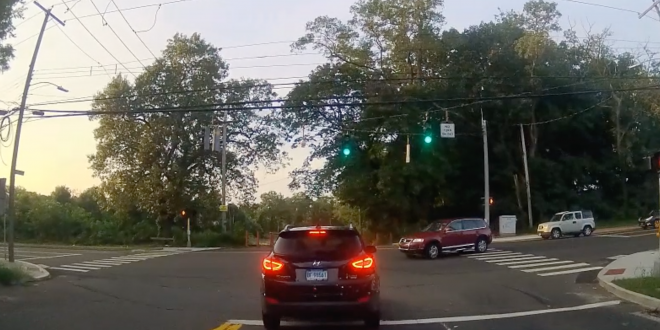NAUGATUCK, CT – Many experienced riders will probably agree that there seems to be many more bad drivers out on the road than ever before. We see them running stoplights, weaving in and out of traffic, and speeding. The dash cam in my truck recently caught two examples of dangerous, potentially deadly, behavior.
In one clip, a driver in a dark red SUV proceeds to run a stoplight at an intersection a full seven seconds after the light turned red. Only the attentiveness of the driver in a black SUV, who waited after getting a green light, prevented an accident.
In the other clip, a driver in a car goes around two cars at a stoplight, moving to the left of the travel lanes into a patch of pavement that wasn’t designated for traffic.. Again, it was a hazardous maneuver.
Bad drivers are everywhere. I’ve even mentioned to groups of new riders in beginner classes that there’s a good chance many of them may currently be “bad” drivers – at least when considered from a motorcyclist’s perspective. They may not realize their deficiencies until they gain experience on motorcycles.
Yes, motorcycling can make you a better driver. Realizing and accepting this is an important step toward becoming a better rider, as well as driver, and can lead to improved 360-degree awareness and perception as one racks up miles of experience.
One of my current bad driving pet peeves that I see too often is when other vehicles barely slow down at stop signs or try to beat a red light. Lately, stopping at red traffic lights seems to be optional for some people. This poor driving trend has been more prolific in some urban areas, but I’ve observed it has become common in suburban and rural areas, too.

Bad drivers feel safe and comfortable in the air-conditioned steel cocoons that have become an extension of their homes. They relax behind the wheel doing many of the same things they do at home – eating, putting on makeup, reading a newspaper or laptop, looking at passengers while talking, dealing with children in the back seat, and, yes, using the infamous cell phone.
These are just a few of the things that can cause a driver to have inattentional blindness, which is not seeing what is plainly visible. And sometimes it is a motorcycle that goes unnoticed.
Inattentional blindness (or just a momentary distraction) shifts focus from the complexities of driving, traffic control, and other roadway users. If this happens to motorcyclists while riding, things can go sideways fast. I covered this topic in a 2012 column in more detail.
Here’s a newer video that explains inattentional blindness in simpler terms with examples:
Most motorcycle crashes or near-crashes with other vehicles occur at intersections. Even if the rider is in the right, he or she can end up dead right. Motorcyclists must take a large part of the initiative to protect themselves from bad drivers and the hazards they cause by developing better perception.
By doing this, they will also become better drivers.
 Ride CT & Ride New England Serving New England, NYC and The Hudson Valley!
Ride CT & Ride New England Serving New England, NYC and The Hudson Valley!



